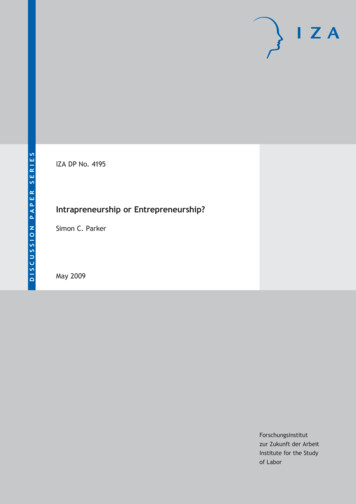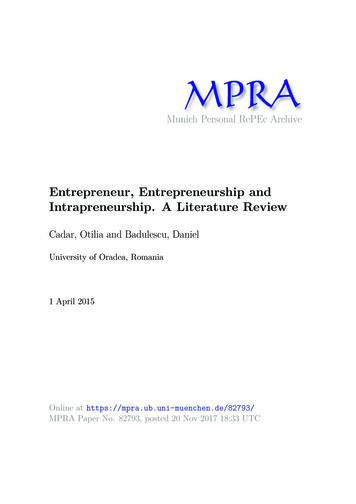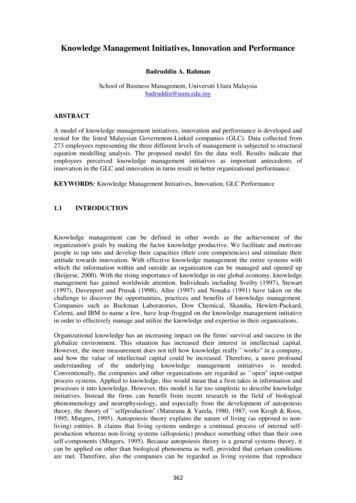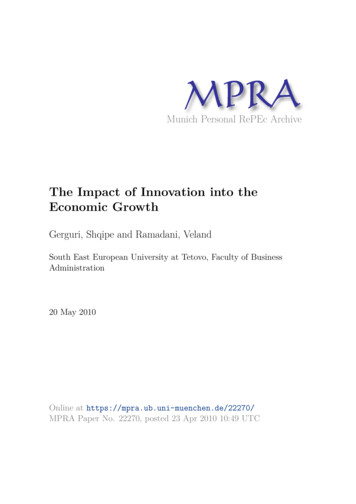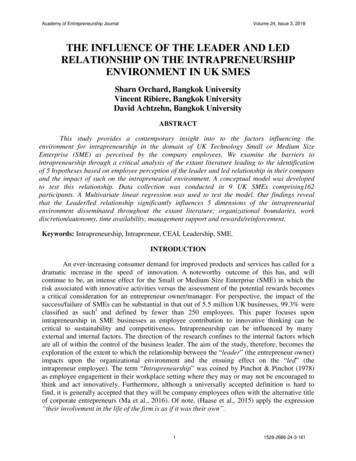
Transcription
Academy of Strategic Management JournalVolume 17, Issue 2, 2017INTRAPRENEURSHIP AND INNOVATIONPERFORMANCE: A CONCEPTUAL MODELMaxwell Olokundun, Covenant UniversityHezekiah Falola, Covenant UniversityStephen Ibidunni, Covenant UniversityOlaleke Ogunnaike, Covenant UniversityFred Peter, Covenant UniversityOladele Kehinde, Covenant UniversityABSTRACTThe motility rate of small and medium enterprises in Nigeria at present is a major asource of concern. This is hinged on the prevailing economic recession leading to organizationalstagnation and non-performance of these firms. However, the innovative activities ofintrapreneurs can be effective at achieving innovative performance within an organization. Thisis based on the premise that intrapreneurs can identify and exploit new business opportunitieswithin their organization or create new ventures under the auspices of their existingorganization. Therefore the objective of this study is to show that the innovative activities ofintrapreneurs can be effective at achieving innovative performance of SMEs in Nigeria. Thearticle also proposed a conceptual model to illustrate the relationship between intrapreneurshipand innovation performance in order to engender innovative performance of SMEs in Nigeria.The study concludes that promoting intrapreneurship in Nigerian firms will play a major role inmotivating as well as creating a platform for employees to express their visionary and creativeabilities aimed at improved innovation performance. This creates an effective organizationalwork environment that keeps businesses in Nigeria competitively well positioned.Keywords: Intrapreneurship, Innovation, Innovative Performance, Nigeria.INTRODUCTIONTechnological changes and globalization result in persistent market competition puttingimmense pressure on small and medium scale enterprises in Nigeria (McDowell, 2017). Therelentless pressure of market competition in Nigeria is increasingly making it more difficult forSMEs to maintain competitive advantage (Osibanjo, Adeniji, Salau & Falola, 2016). Small andmedium scale enterprises are faced with the options of either becoming one of the market leadersor experience stagnation; hence this explains the recession and high mortality rate of small andmedium scale enterprises experienced in Nigeria at present. One of the strategies small andmedium scale enterprises in Nigeria can adopt as regards combating stagnation and the adverseeffects of recession is to encourage the expression of entrepreneurial behavior by its employees(Ogbari, Oke, Ibukunoluwa, Ajagbe & Ologbo, 2016). This would result in employees mappingout new strategies, initiating new venture creation within their organizations and breaking newfrontiers aimed at innovation performance. Intrapreneurship is a major driver of innovativeperformance particularly because it enhances employees to express behaviors aimed at11939-6104-17-2-187
Academy of Strategic Management JournalVolume 17, Issue 2, 2017identifying and exploiting new ideas, new strategies for business growth and new ways ofrunning an existing business (Lambert, 2016). This paper argues that organizational innovationsare not necessarily as a result of established research processes but are the result ofentrepreneurial employee behavior that disturbs traditional business practice. Therefore, theobjective of this study is to show that the innovative activities of Intrapreneurs within SMEs inNigeria can be effective at achieving innovation performance. This study was based on aconceptual approach geared towards the development of concepts, clarification of meanings aswell as establishment of the linkages proposed. Thus the study proposed a conceptual model toillustrate the relationship between intrapreneurship and innovation performance as a basis forfostering innovation performance of SMEs in Nigeria.Intrapreneurship and SMEs in NigeriaIntrapreneurship as a process engenders rejuvenation within an existing organization(McDowell, 2017). This is consequent upon the fact that intrapreneurship involves the processby which individuals in an organization identify and exploit new business opportunities withintheir organization or create new ventures under the auspices of their existing organization(Chrisman, 1999; Zgheib, 2017). Therefore, creating a platform for the expression ofintrapreneurial behavior in small businesses in Nigeria could culminate into identification andexploitation of viable business opportunities that can stimulate productivity (Lambert, 2016).Intrapreneurs within an organization act instinctively aimed at identifying and exploiting newapproaches for business growth and development (Daryani & Karimi, 2017). Therefore, smallbusinesses in Nigeria can stimulate the emergence of intrapreneurs through innovation activismby fostering the expression of entrepreneurial behavior by independent intrapreneurs within theorganization. Small businesses in Nigeria can also stimulate the emergence of intrapreneursthrough innovative capabilities which will involve a conscious effort by SMEs owners to trainemployees for innovation (Aparicio, 2017). This will ascertain that conceived ideas areharnessed, experimented, assessed, re-structured and eventually brought to light (Olokundun etal., 2017).Intrapreneurship and Innovation within SMEs in NigeriaThere is a strong linkage between innovation and entrepreneurial behavior of employeeswithin an organization resulting in organizational growth and performance (McDowell, 2017).Intrapreneurs are regarded as innovators within an organization because Intrapreneurshipenhances employees to express behaviors aimed at identifying and exploiting new ideas, newstrategies for business growth and new ways of running an existing business (Rivera, 2017;Braunerhjelm, 2009). It is important to state that small businesses in Nigeria require new ideasand strategies to survive as well as maintain an acceptable growth and profitability level.Therefore, they have to come up with strategies to exploit the intrapreneurial and innovativepotentials resident in their employees (Innovation Booster, 2017). To this end, small businessowners in Nigeria are saddled with the responsibility to create an intrapreneurial and innovativeculture that can motivate the expression of entrepreneurial behavior within an organization whichengenders growth and appreciable profitability level.21939-6104-17-2-187
Academy of Strategic Management JournalVolume 17, Issue 2, 2017Innovation Performance and SMEs in NigeriaFrom the perspective of the organization, innovation is considered an important factor forperformance and growth via improvements in efficiency, productivity, quality, competitivepositioning and growth of a firm. Innovation is substantiated in the introduction of new products,processes or services (Bagno et al., 2017). Innovation involves a management process thatinvolves strategic approaches with a focus on process technology, market innovation, operationinnovation and product differentiation (Emmanuel, 2008; Suhag et al., 2017). Therefore forSMEs in Nigeria to achieve innovation performance, the activities of the firms must emphasizethe introduction of new and relevant ideas to the entirety of organizational processes andprocedures for developing and acting on strategies aimed at significant organizationalimprovements reflected in improved or new business products, services or internal processes(Yang et al., 2017).Specifically, the activities of intrapreneurs in SMEs in Nigeria can be evident in processtechnology which usually results in reduction of cost of production (Emmanuel, 2008;Kogabayev & Maziliauskas 2017). This facilitates reduction in product or service price which inturn increases the demand for the product or service of the firms. This can enhance innovationperformance of small businesses in Nigeria in the sense that an increase in demand could suggestan increase in productive level that could enhance profitability of the businesses. Similarly,Intrapreneurs within small businesses in Nigeria could help carve a niche for their organizationthrough the concept of product differentiation (Mukhopadhyay & Ye, 2017). The uniqueness ofthe product of the organization could attract new customers or segment of the market. This maybring about an increase in the demand for the product of the firms placing the organizations in acompetitive position in the market.In the same vein, innovation and intrapreneurship within an organization is targeted atimproved customer satisfaction and reduction in cost of production (Lambert, 2016). Thusintrapreneurs within small businesses in Nigeria can reinvent the organizations and enhanceefficiency by eliminating unnecessary bureaucratic processes, tapping into the gains oftechnology and adopt models of effective delegation of power and authority aimed at improvedefficiency and effectiveness (Lambert, 2016). Intrapreneurs within SMEs in Nigeria can offermore value to customers by focusing intensely on customer satisfaction. This could be achievedby the development of innovative strategies of reducing inconveniences to the customers andenhancing the organization to adopt structure that makes its operations customer friendly.Intrapreneurs within SMEs in Nigeria can also enhance the market offerings of the organizationby providing additional features to its market offerings or by adding extra value to theorganization’s product or service at the same selling price. This strategy of intrapreneurialinnovation usually comes to bear especially as a survival strategy for the organization (Essegbeyet al., 2017). Hence, this is salient to the Nigerian context considering the high mortality rate ofSMEs in the country.31939-6104-17-2-187
Academy of Strategic Management JournalVolume 17, Issue 2, 2017FIGURE 1A CONCEPTUAL MODEL FOR INTRAPRENEURSHIP AND INNOVATIONPERFORMANCECONCLUSIONPromoting innovative performance is a step in the right direction for SMEs in Nigeriathat seek to combat organizational stagnation or decline particularly in today’s very competitiveand turbulent business world. Innovation performance must be an organizational culture in orderto encourage the expression of entrepreneurial and innovative behavior by employees. This willenhance the exploitation of the valuable entrepreneurial talents in employees of SMEs in Nigeria.Knowledge is regarded as the source of power in these modern times, thus harnessing thepotentials of employees is pivotal to innovative performance. Increase in profitability is afunction of value creation strategy which is of utmost importance particularly in a knowledgedriven world. Thus, encouraging innovative performance is vital for sustained profitability forSMEs in Nigeria. To this end, intrapreneurs play a major role in motivating employees as well ascreating a platform for employees to express their visionary and creative abilities aimed atimproved innovative performance. This will create an effective organizational work environmentfor SMEs in Nigeria keeping businesses competitively well positioned.ACKNOWLEDGEMENTThe authors wish to appreciate the management of Covenant University for offering fullsponsorship for this research work.REFERENCESAparicio, M.E. (2017). Driving and inhibiting factors for intrapreneurship: A study of intrapreneurship teams.Master’s Thesis in Master of Technology Management, Norwegian University of Science and TechnologyFaculty of Social Sciences and Technology Management Department of Industrial Economics andTechnology Management.Bagno, R.B., Salerno, M.S. & Dias, A.V.C. (2017). Innovation as a new organizational function: Evidence andcharacterization from large industrial companies in Brazil. Production, 27.Barker, V.L. & Duhaime, I.M. (1997). Strategic change in the turnaround process: Theory and empirical evidence.Strategic Management Journal, 18(1), 13-38.41939-6104-17-2-187
Academy of Strategic Management JournalVolume 17, Issue 2, 2017Braunerhjelm, A.Z. & Audretsch, C.B.D. (2009). The knowledge spillover theory of entrepreneurship. SmallBusiness Economics, 32(1), 15-30.Connolly, P. & Klein, L.C. (1999). The National Nonprofit Leadership and Management Journal, 17(3).D’Aveni, R.A. (1989). The aftermath of organizational decline: A longitudinal study of the strategic and managerialcharacteristics of declining firms. Academy of Management Journal, 32(3), 577-608.Daryani, M.A. & Karimi, A. (2017). Effect of corporate entrepreneurship on firm performance in Iranian ASMEs:The mediation role of knowledge creation and learning orientation. Journal of Agricultural Science andTechnology, 19(2), 261-277.Emmanuel, C.L. (2008). Entrepreneurship a conceptual approach (2nd Edition). Pumark Nigeria Limited EducationPublishers.Essegbey, G.O., Sakyi-Dawson, O., Kossou, D., Ouologuem, B., Dembele, F., Adu Acheampong, R. & Jiggins, J.(2017). External influences on agro-enterprise innovation platforms in Benin, Ghana and Mali-options foreffective responses. Cahiers Agriculture, 26, 1-9.Gomes, G. & Wojahn, R.M. (2017). Organizational learning capability, innovation and performance: Study inSmall and Medium-Sized Enterprises (SMES). Re vista de Administração, 52, 163-175.Rivera, M.J. (2017). Leveraging innovation & intrapreneurship as a source for organizational growth. InternationalJournal of Innovation Science, 9(2), 137-152.Ibidunni, S., Osibanjo, O., Adeniji, A., Salau, O.P. & Falola, H. (2016). Talent retention and organizationalperformance: A competitive positioning in Nigerian banking sector. Periodica Polytechnica Social andManagement Sciences, 24(1), 1-13.Innovation Booster (2017). Intrapreneurs: The necessary employees for established organizations today.Kogabayev, T. & Maziliauskas, A. (2017). The definition and classification of innovation. Holistica, 8(1), 59-72.Lambert, L. (2016). Intrapreneurship: Adding entrepreneurial value and innovation within a corporation 50 billiondollar boss: African American women sharing stories of success in entrepreneurship and leadership.Lorange, P. & Nelson, R.T. (1987). How to recognize and avoid-organizational decline. Sloan Management Review,28(3), 41-46.Mcdowell, T.C. (2017). A comprehensive study of intrapreneruship as a cultural form of innovation and sustainablecompetitive advantage. A dissertation submitted to the Bisk College of business at Florida institute oftechnology in partial fulfillment of the requirements for the degree of doctor of business administration.Mukhopadhyay, S.K. & Ye, G. (2017). Effect of CSR on product differentiation in the presence of cost advantage.Journal of Economic and Social Development, 4(1), 15-26.Ogbari, M.E., Oke, A.O., Ibukunoluwa, A.A., Ajagbe, M.A. & Ologbo, A.C. (2016). Entrepreneurship and businessethics: Implications on corporate performance. International Journal of Economics and Financial Issues,6(3), 50-58.Olokundun, M.A., Ibidunni, A.S., Peter, F., Amaihian, A.B., Moses, C.L. & Iyiola, O.O. (2017). Experientialpedagogy and shared vision: A focus on identification of business opportunities by Nigerian universitystudents. Journal of Entrepreneurship Education, 20(2), 1-12.Pretorius, M. (2009). Defining business decline, failure and turnaround: A content analysis. SAJESBMNS, 2(1).Sharma, P. & Chrisman, J.J. (1999). “Toward a reconciliation of the definitional issues in the field of corporateentrepreneurship”. Entrepreneurship Theory and Practice, 23(3), 11-17.Suhag, A., Solangi, S.R., Larik, R.S.A., Lakho, M.K. & Tagar, A.H. (2017). The relationship of innovation withorganizational performance. International Journal of Research: Granthaalayah, 5(2), 292-306.Vargas-Halabí, T., Mora-Esquivel, R. & Siles, B. (2017). "Intrapreneurial competencies: Developmentandvalidation of a measurement scale". European Journal of Management and Business Economics, 26(1), 86111.Weitzel, W.F. & Jonsson, E. (1991). Reversing the downward spiral: Lessons from W.T. Grant and Sears Roebuck.Academy of Management Executive, 5(3), 7-21.Yang, Z., Sun, J., Zhang, Y. & Wang, Y. (2017). Green, green, it’s green: A triad model of technology, culture andinnovation for corporate sustainability. Sustainability, 1-23.Zgheib, P.W. (2017). Corporate innovation and intrapreneurship in the Middle East entrepreneurship and businessinnovation in the Middle East.51939-6104-17-2-187
performance and growth via improvements in efficiency, productivity, quality, competitive positioning and growth of a firm. Innovation is substantiated in the introduction of new products, processes or services (Bagno et al., 2017). Innovation involves a management process that involves strategic approaches with a focus on process technology .
